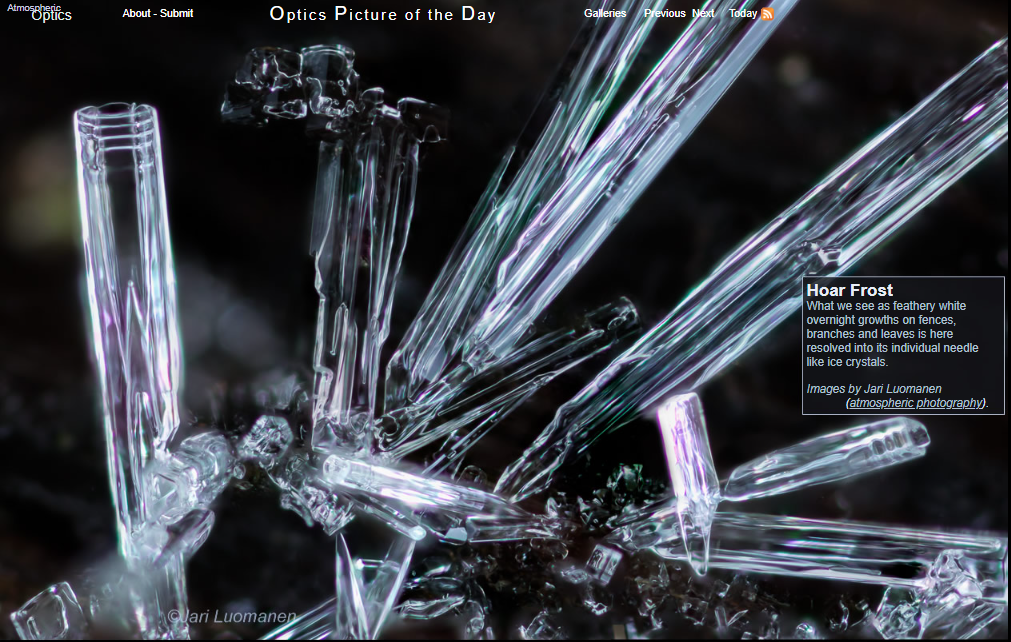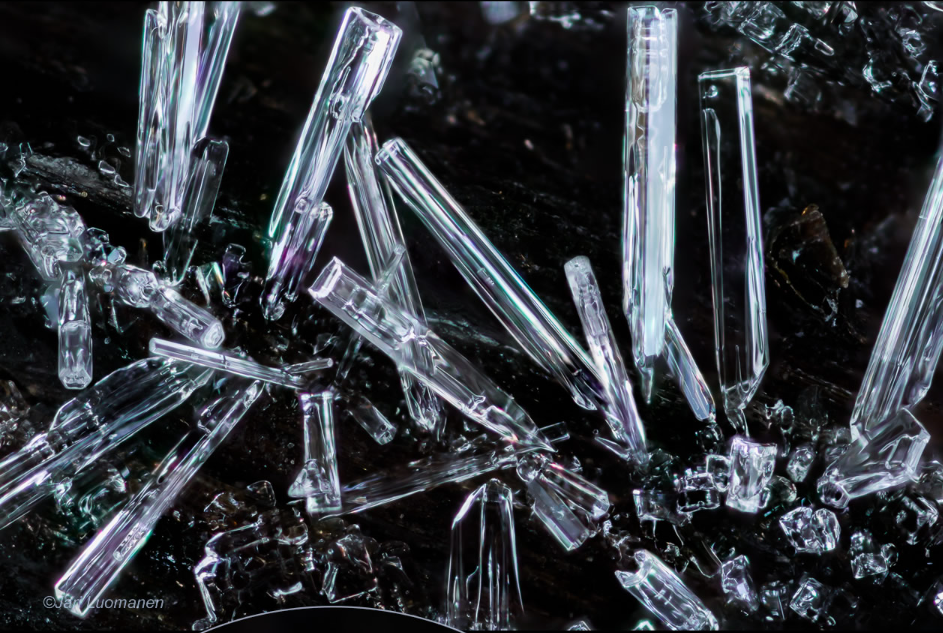Hoar Frost Crystals - OPOD
Hoar Frost Crystals - An Enchanting Winter Phenomenon
When the temperature drops below freezing during the night, a magical transformation occurs in the natural world. Delicate, feathery white growths appear on fences, branches, and leaves, creating a stunning spectacle known as hoar frost. In this article, we will delve into the mesmerizing world of hoar frost crystals and explore their intricate structures.
The Formation of Hoar Frost
As the air cools overnight, the water vapor present in the atmosphere can eventually reach saturation. When the temperature is above freezing, the excess water condenses into dew. However, when the temperature drops below 0°C (32°F), the water vapor undergoes a phase change and transforms into solid ice. This frozen water vapor then accumulates on surface irregularities, forming long columnar hexagonal crystals.
Unveiling the Hexagonal Beauty
To truly appreciate the captivating beauty of hoar frost crystals, we must examine their individual structures. These crystals resemble needle-like ice formations, each composed of hexagonal prisms. The hexagonal shape is a reflection of ice's molecular structure, which consists of oxygen atoms represented by red balls and hydrogen atoms depicted as white sticks in a chemist's ball and stick model.
Within the realm of hexagonality, nature showcases an incredible diversity of crystal formations. These crystals can vary in length, with some being hollow or possessing a pyramidal end. Additionally, their hexagon prisms may exhibit irregularities, such as unequal side lengths. However, one feature remains constant—the interfacial angles. These angles adhere to the atomic planes of the crystal structure, which are orders of magnitude smaller in size.
Exploring Crystal Imperfections
In certain cases, hoar frost crystals may exhibit imperfections, such as hollow prisms. While these imperfections may not hinder the awe-inspiring beauty of hoar frost in the natural world, they can impact the optical phenomena associated with these crystals. When hoar frost crystals with hollow prisms are present in clouds, they tend to produce poor and indistinct halos or may not generate halos at all.
Unraveling the Mysteries of Hoar Frost Crystals
The study of hoar frost crystals has fascinated scientists and enthusiasts alike. Researchers continue to explore the intricate details of these delicate ice formations to gain a deeper understanding of their formation and properties. By examining the various types of hoar frost crystals and the factors influencing their growth, scientists aim to unravel the mysteries behind this enchanting winter phenomenon.
The Visual Splendor of Hoar Frost
The visual appeal of hoar frost is undeniable. The delicate, feathery structures transform the landscape into a winter wonderland, casting a spell of enchantment over everything they touch. From frost-covered branches to glistening leaves, hoar frost creates a breathtaking spectacle that delights both the young and the young at heart.
Capturing the Beauty of Hoar Frost Crystals
Photographers and artists often find themselves captivated by the ethereal beauty of hoar frost crystals. With their intricate structures and glistening surfaces, these ice formations provide endless inspiration for creative endeavors. The challenge lies in capturing the delicate details and shimmering essence of hoar frost through various artistic mediums.
Embracing the Magic of Winter
Hoar frost crystals serve as a reminder of the wonders that winter brings. As nature undergoes its transformation during the cold season, we are presented with an opportunity to embrace the magic that lies within. From the delicate intricacies of hoar frost to the crisp air that fills our lungs, winter offers a unique experience that invites us to appreciate the beauty in every frozen moment.
Conclusion
The world of hoar frost crystals is a captivating one, filled with intricate structures and enchanting beauty. As we marvel at these delicate ice formations, we are reminded of the magic that winter bestows upon the natural world. Whether it's the shimmering branches or the glistening leaves, hoar frost crystals create a mesmerizing spectacle that evokes a sense of wonder and awe. So, the next time you encounter hoar frost, take a moment to appreciate the intricate beauty that lies within each delicate crystal.

Hoar Frost
What we see as feathery white overnight growths on fences, branches and leaves is here resolved into its individual needle like ice crystals.
Images by Jari Luomanen (atmospheric photography).

As air cools overnight its water vapour can eventually reach saturation. Above 0°C the excess water condenses into dew. Below 0° the vapour changes phase to the solid – ice. The ice grows on surface irregularities as long columnar hexagonal crystals.
The hexagons reflect ice’s molecular structure shown at left as a chemist’s ball and stick model. Red balls are oxygen atoms. Along each white stick is a hydrogen atom.
Nature shows great variety within the confines of hexaganality. Crystals differ in length, are sometimes hollow, sometimes with one end pyramidal. Their hexagon prisms can be 'irregular', of unequal side length. What is invariant are the interfacial angles for they must follow the planes of atoms, orders of magnitude below in size.



Hollow prism. Crystals with such 'imperfections' in clouds give poor and indistinct halos or none at all.
Note: this article has been automatically converted from the old site and may not appear as intended. You can find the original article here.
Reference Atmospheric Optics
If you use any of the definitions, information, or data presented on Atmospheric Optics, please copy the link or reference below to properly credit us as the reference source. Thank you!
-
<a href="https://atoptics.co.uk/blog/hoar-frost-crystals-opod/">Hoar Frost Crystals - OPOD</a>
-
"Hoar Frost Crystals - OPOD". Atmospheric Optics. Accessed on December 28, 2024. https://atoptics.co.uk/blog/hoar-frost-crystals-opod/.
-
"Hoar Frost Crystals - OPOD". Atmospheric Optics, https://atoptics.co.uk/blog/hoar-frost-crystals-opod/. Accessed 28 December, 2024
-
Hoar Frost Crystals - OPOD. Atmospheric Optics. Retrieved from https://atoptics.co.uk/blog/hoar-frost-crystals-opod/.